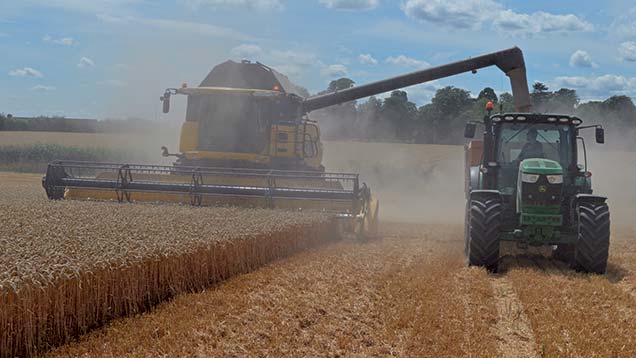Milling wheat harvest sees good quality grain

Breadmaking wheats are showing good quality from this harvest with key varieties performing well, according to a survey by one the UK’s biggest bread and milling groups, Rank Hovis.
The company which buys about one million tonnes of milling wheat annually says grain protein contents, specific weights and hagbergs were all generally good.
See also: Harvest 2015: Nearly half UK wheat cut, 25% of spring barley complete
All widely grown group 1 milling wheats Crusoe, Gallant, Skyfall and Solstice did well with results heavily skewed to crops cut in south and eastern England.
“This year’s growing conditions have suited the development of group 1 wheat with good levels of functional protein,” says Shaun Taylor, head of technical at Rank Hovis.
With nearly three-quarters of the milling wheat crop cut by the end of August, the four main varieties showed protein levels close to 13% and hagberg well over 300.
The survey, the biggest of its kind in the UK compiled with the help of the breadmakers’ suppliers, was based on samples taken before heavy rains slowed progress in late August.
The results (see table) may underplay hagberg, as many merchants don’t record above 300, and these quoted levels could be 40 higher, says Gary Sharkey, head of commodities at Hovis.
Hagberg levels, which measure gluten quality, may start to come down as crops in the North are cut, but it would have to be a big fall before wheat becomes unuseable.
| Rank Hovis 2015 interim milling wheat survey results | |||
| Protein (%) | Specific weight (kg/hl) | Hagberg | |
| Crusoe | 13.0 | 80.5 | 312 |
| Gallant | 12.7 | 79.8 | 347 |
| Skyfall | 12.7 | 81.0 | 336 |
| Solstice | 13.0 | 80.9 | 323 |
“We might also expect protein to decline slightly as more northern samples come in – that’s quite normal,” he adds.
A national wheat crop of about 16m tonnes is now expected, and according to official figures the milling industry used 6.8m tonnes last season of which 5.6m tonnes or 82% was home-grown.
Mr Sharkey says that more of the UK’s total wheat tonnage is likely to come from high yielding group 1 milling varieties in the future.
“The introduction of higher yielding breadmaking varieties means growing under contract might be a sensible option for harvest 2016,” he says.
One new variety widely grown for the first time this season, Skyfall, had a good showing in early baking test by Rank Hovis which confirmed the variety’s place as a top milling wheat.
The group had deferred its decision on the variety until it had seen commercial volumes this harvest, amid some concern over how low protein samples would bake.
“We are extremely pleased to say that early bake data confirms Skyfall’s place as a group 1 breadmaking wheat with results as good as Solstice and Crusoe,” says Mr Taylor.
Farm manager Andrew Robinson is one grower managing to achieve high yields and proteins on his milling wheats at Heathcote Farms, Toddington, Bedfordshire.
“There has been a lot of talk about protein dilution with high-yielding milling wheats – they need good management,” says Mr Robinson.
His 112ha of Skyfall averaged 13.53t/ha at 14.1% grain protein, while Gallant yielded 12.72t/ha with a protein content of 12.91%.
“We applied 292kg/ha of nitrogen, including 40kg/ha on the ear, and we also apply plenty of trace elements to our wheats to make the most of their potential,” he says.
Mr Sharkey says meeting minimum contract milling specifications – traditionally 13% protein, 76kg/hl specific weight and 250 hagberg are important for both growers and millers.
“While Skyfall has a natural ability to yield, it is imperative the variety is grown to target the correct end-user requirements,” he adds.
To help growers meet milling wheat specification and avoid protein dilution while maximising yields, RAGT Seeds, the breeder of Skyfall, is producing a new guide, which will be available in November.

